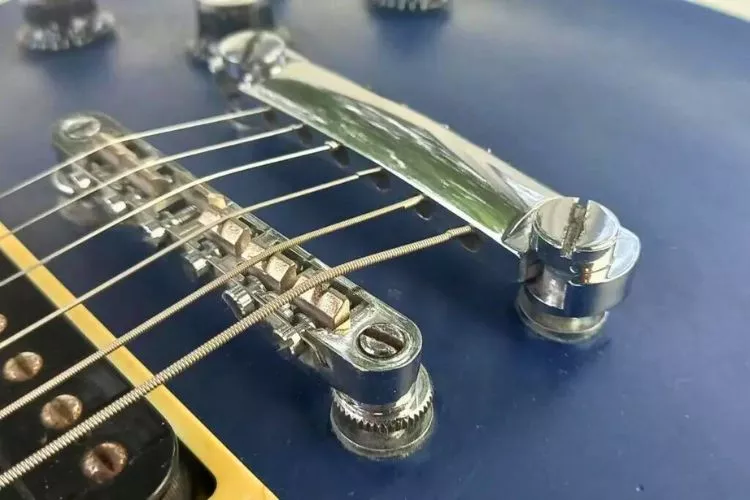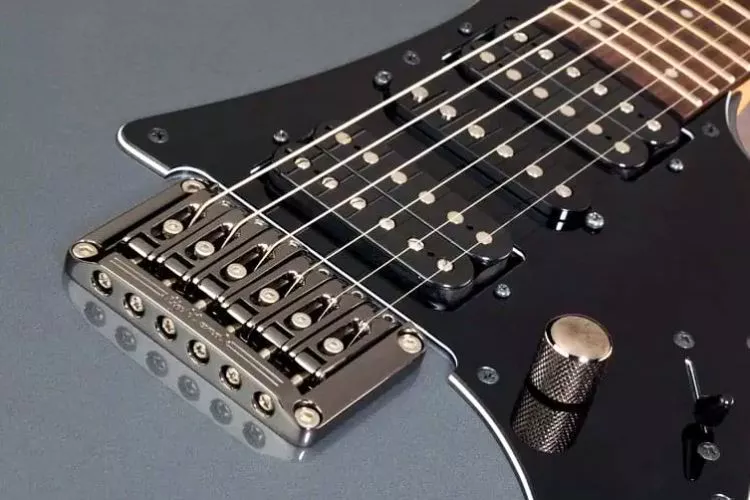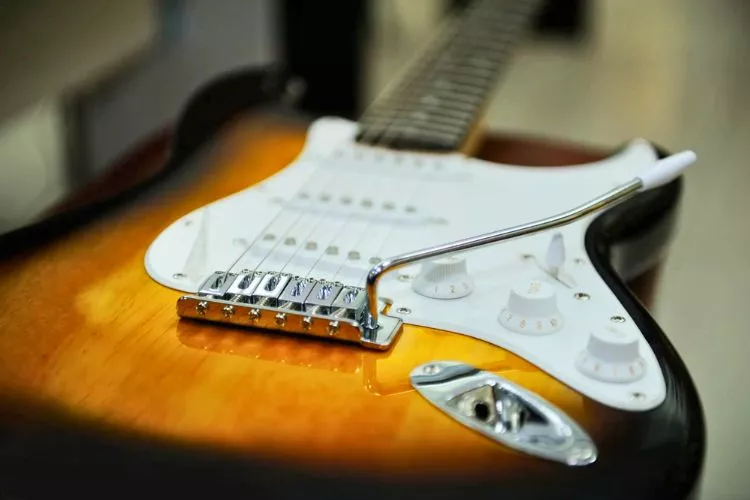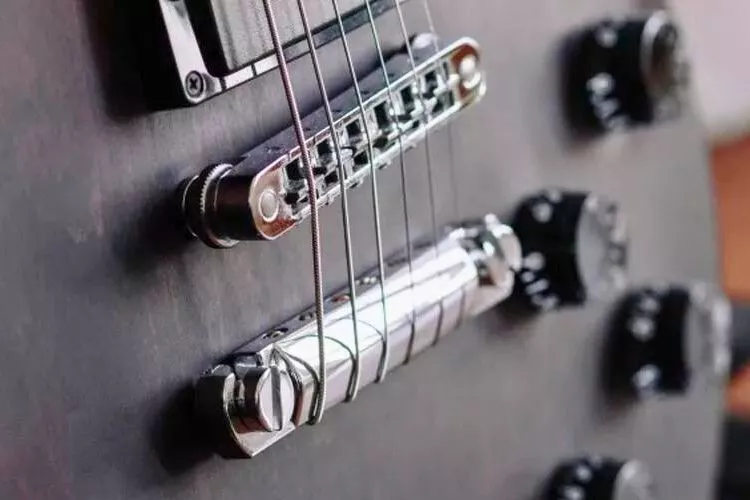In the diverse world of guitars, each design has a unique voice to contribute. Among these, the hardtail guitar holds a significant place. Today’s topic: What is a hardtail guitar? Characterized by its fixed bridge system, the hardtail guitar offers unparalleled tuning stability and precision tonal control.

This article delves into understanding the hardtail guitar, exploring its characteristics, advantages, and the key role it has played in shaping music across eras and genres. Whether you’re a novice embarking on your musical journey or an experienced guitarist, join us as we unravel the mystique around the hardtail guitar.
Contents
🎶What is a hardtail guitar?
A hardtail guitar, as the name suggests, is a type of guitar with a “hard” or “fixed” tail, referring to its bridge system. Unlike guitars with tremolo or floating bridges, which can be adjusted to modulate pitch and create vibrato effects, the bridge on a hardtail guitar is immovable.
Typically, this results in better tuning stability as there are fewer components that can potentially shift or change. Hardtail guitars are highly cherished by many guitarists for their simplicity, ease of maintenance, reliable tuning stability, and the consistent tonal quality they provide.
The Fender Stratocaster, one of the most iconic hardtail guitars, is popular amongst players of all genres, showcasing the guitar’s versatility. The hardtail guitar’s distinctive tonality and stability have made it a preferred choice for various musicians over the decades, perfect for those seeking precision in their sound.
🎶What is a hardtail electric guitar?
A hardtail electric guitar is a type of electric guitar that utilizes a fixed bridge system, the “hardtail”, hence its name. This means the bridge, where the strings are anchored, doesn’t move or fluctuate – unlike tremolo or floating bridge systems found in other types.

This fixed system provides greater tuning stability as the strings stay in place more reliably, ensuring fewer detuning issues. As there are fewer moving parts, hardtail electric guitars often offer simplicity in design, maintenance, and ease of play for the guitarist.
While the hardtail design doesn’t allow for the pitch bend or vibrato effects possible with tremolo bridge systems, many guitarists prefer the hardtail for its crisp, consistent tonality and increased sustain. Iconic models like the Fender Telecaster and some versions of Stratocaster are examples of hardtail electric guitars, beloved by musicians across diverse genres.
🎶What is the difference between tremolo and hardtail guitars?
Tremolo and hardtail guitars are differentiated by their bridge systems, influencing their playability, tonal properties, and tuning stability.
A tremolo guitar features a “floating” or moveable bridge system, which allows the player to temporarily modify the pitch of the strings by manipulating a tremolo arm, also known as a “whammy” bar.
This system enables the creation of unique effects such as vibrato, pitch bends, and dive bombs, adding expressive capabilities to a guitarist’s performance. However, entire tuning stability can be compromised if the tremolo system isn’t well maintained or correctly used, necessitating frequent retuning.
On the other hand, a hardtail guitar has a ‘fixed’ bridge system that doesn’t move or adjust. The strings on a hardtail guitar are more stable and maintain their tuning more reliably, making hardtail guitars a good choice for beginners or for styles where consistent pitch is of the utmost importance. Hardtails are generally simpler to maintain as they have fewer moving parts. They offer more sustain and are known for a clear and defined tone.
So, the choice between tremolo and hardtail largely depends on your style of play, with tremolo offering more dynamic pitch alterations and hardtail providing tonal consistency and stability.
🎶What is a hardtail guitar good for?
A hardtail guitar is known for its excellent tuning stability, tonal consistency, easier maintenance, and versatile playability across various music styles. Below are some details highlighting what a hardtail guitar is good for:

- Tuning Stability: The fixed bridge system in a hardtail guitar maintains secure contact between each string and the guitar body, ensuring better tuning stability. Fewer moving parts minimizes the risk of detuning, making it ideal for those who prioritize consistent tuning in their performances.
- Tonal Consistency and Clarity: The fixed bridge system enhances resonance, leading to a clear and defined tone that appeals to guitarists who look for precision in their sound. Additionally, hardtail guitars tend to have more sustain, enabling longer-lasting notes that can be particularly helpful in genres like blues, jazz, and ambient music.
- Easy Maintenance: Hardtail guitars lack the complexity of tremolo systems, which translates to fewer parts requiring adjustment or replacement. This ensures easy upkeep and lower costs for repairs or modifications.
- Beginner-friendly: Hardtail guitars are ideal for beginners due to their easy playability and tuning stability. The simpler design helps new players focus on developing proper techniques and establishing a solid foundation in guitar playing before experimenting with more dynamic systems like tremolos.
- Versatility Across Genres: Hardtail guitars can be found in various music styles, as their tonal consistency, clear sound, and ease of play make them an adaptable choice. From rock, jazz, blues, country, to fingerstyle and pop, hardtail guitars have been widely used and loved by musicians.
- Affordability: While there are high-end models available, hardtail guitars can be found at more budget-friendly prices. The simpler design and decreased need for additional components like springs or tremolo arms contribute to a more affordable instrument without compromising the quality of sound.
- String Changing Ease: Due in part to their fixed bridge, hardtail guitars make changing strings faster and less complicated. Restringing is more straightforward, offering less downtime between string changes for avid players and performers.
In summary, hardtail guitars are celebrated for their tuning stability, tonal clarity, low maintenance, broad versatility across styles, and overall accessibility to players at all skill levels. They are a reliable and attractive option for those seeking a guitar that focuses on quality sound and playability.
🎶Is a hardtail guitar good for beginners?
A hardtail guitar is a favorable choice for beginners due to several key advantages: its reliable tuning stability, simpler design, easier maintenance, and its straightforwardness to play. Here is a more detailed description:
- Tuning Stability: A significant concern for beginners is constantly having to retune their guitars. Since hardtail guitars have fixed bridges with no moving parts, they remain in tune longer than their tremolo counterparts. This feature allows beginners to focus on practicing and improving their skills without fretting about their guitar going out of tune frequently.
- Simplified Design: The design of hardtail guitars is more straightforward compared to guitars with tremolo systems. This simplicity makes it easier for novices to understand the parts and functions of their instrument, letting them concentrate more on playing and less on dealing with the guitar’s mechanics.
- Ease of Maintenance: Hardtail guitars are easier to maintain as there are fewer mechanical parts that could break or need adjustment. For beginners who do not yet have the experience or knowledge in guitar maintenance, this ease of upkeep can be highly beneficial.
- Beginner-friendly Playability: Hardtails are often easier to play for beginners. They require less hand pressure to make clean notes since there isn’t a floating bridge, which might need a greater force to ensure the strings are making solid contact with the frets.
- Easy String Changes: Changing strings on hardtail guitars is usually more straightforward and less intimidating for beginners. You don’t need to balance the tension of the tremolo springs while restringing.
- Versatility Across Genres: Hardtail guitars are not limited to specific genres of music. They offer a broad tonal range suitable for rock, pop, country, blues, jazz, and more. Thus, beginners can experiment with different styles and find their musical preferences.
- Affordability: Generally, hardtail guitars are less expensive than equivalent models with tremolo systems. This price difference makes them an attractive choice for beginners who may not want to invest heavily in their initial instrument.
In sum, hardtail guitars are an excellent choice for beginners due to their user-friendly design, easy maintenance, reliable tuning, and versatile functionality in numerous musical styles. They offer beginners a reliable and simplified way to start their guitar learning journey without the added complexity of tremolo systems.
🎶What is a hardtail guitar for beginners?
Here are some hardtail guitars recommended for beginners:

- Squier Bullet Mustang HH: This guitar is well-suited for beginners because of its affordable price point, simplistic design, and quality construction. It provides a comfortable playing experience with a solid body and easy maneuverability.
- Yamaha Pacifica 112V: The Yamaha Pacifica series is notable for its versatility and reliability. The 112V model comes with a hardtail bridge that contributes to tuning stability, making it suitable for beginners.
- Epiphone SG Modern Figured: An excellent choice for burgeoning rockers, this hardtail guitar has a stylish look coupled with a smooth, robust sound.
- Squier Contemporary Stratocaster HH FR: A part of the renowned Stratocaster series, this model features a rugged hardtail bridge and a dual humbucker configuration, great for those looking to explore the rock and metal genres.
Do keep in mind, selection of a guitar is personal and depends on the music styles you’re interested in, your comfort level, and of course, your budget. The models recommended above are commonly suggested for beginners due to their playability, durability, and affordability.
Other guitar related articles: How often do Guitar Strings Break? | Best Capo for Classical Guitar
Conclusion:
A hardtail guitar is a type of electric guitar that features a fixed bridge system. This construction provides excellent tuning stability, consistent tonality, easy restringing, and simplified maintenance, making it a popular choice among musicians of diverse genres. Though it may not provide the same range of vibrato effects as mock-tremolo systems, the trade-off is a guitar that delivers clear and sustained notes, is more reliable, easier to take care of, and generally more beginner-friendly.
Whether you’re a budding guitarist looking for your first instrument, or an experienced player seeking a workhorse that stays reliable under varying conditions, a hardtail guitar’s simplicity, utility, and tuning stability make it a sound addition to any musician’s arsenal. Ultimately, the choice between a hardtail guitar and others with different bridge systems depends on the individual player’s stylistic preferences, technical needs, and comfort.
